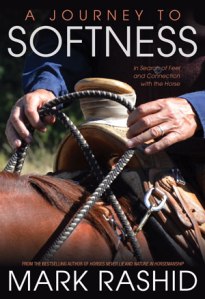When you are in the book-making business, it is remarkable when one book, in particular and out of the hundreds of others, stays with you. Whatever you are doing, at your desk or in the saddle, making dinner or cleaning up after, the words or ideas or themes just keep surfacing. It’s like gazing out over the side of a boat and watching dolphins gracefully arc up for air and slide back down out of sight…only to arise again a little further on, perhaps this time with a bit more fanfare. Its soothing and invigorating at the same time. Sailors used to say it was good luck. You wanting them to stay with you, guiding you, keeping time and space in its place.
Mark Rashid’s most recent book A JOURNEY TO SOFTNESS is one that stays with you in this way. Rashid shares his lessons as only a master storyteller can: quietly, convincingly, meaningfully. Few words are words alone—they all are weighted with meaning. And there aren’t too many, or too few. I hesitate not for a second in saying that this book is for every horseman and every rider, regardless of discipline or level of ability or competitive aspirations. It will leave you a better, more thoughtful person beside a horse and on his back; it will lead you to greater things in partnership.
And what exactly is “softness”? It is having the sensitivity we need in order to understand when and if the horse tries to “give.” It is about developing the kind of awareness it takes to know when we are working against our horses rather than with them. It is intrinsically linked to the “feel” and connection we all seek—whatever type of horse we ride and whatever kind of saddle we swing up over his back.

Here are 10 things that I learned from A JOURNEY TO SOFTNESS that keep surfacing, keep my boat on course, and keep me certain I’m this much closer to reaching the destination I desire:
1 It’s not what we do that starts us on the path to softness—it’s what we don’t do.
2 Soft hands is a good start, but it doesn’t stop there. Remember your horse feels your entire body.
3 Be a good “dance partner”: be a respectful presence, allow thoughts and movements to blend together, hear the same music.
4 Your “handshake” should be soft, yet very connected—even powerful. Capable of delicate, intricate work, yet strong enough to fix things that need fixing.
5 We think that a touch is a touch and contact is contact…but it isn’t. Each different initial contact invites a different response…the quality of the initial contact creates the magic.
6 If you want to move something without damaging it, don’t back up and hit it as hard as you can—gently nudge it along until the flow of energy helps it gain the desired speed.
7 Find and stride the “edge of balance”—a point where both you and your horse know what you will do next…even though you haven’t done it yet.
8 Learn to be okay with “not knowing”—being curious, wondering, having questions helps you be present.
9 Good helicopter pilots spend their flying time secure in the knowledge they can handle whatever is about to go wrong. Be a good “helicopter pilot.”
10 It’s not about working on the horse, it is about being willing to work on the inside of yourself.
The best sailors are the ones who do not need or rely on instruments to steer their craft and trim their sails—they need only the feel of the craft and the feel of the sea. And those “good luck dolphins” cresting beside them.
A JOURNEY TO SOFTNESS is available now from the TSB online bookstore, where shipping in the US is FREE.
CLICK HERE to download a free excerpt.
–Senior Editor, Rebecca Didier
Trafalgar Square Books, the leading publisher of equestrian books and DVDs, is a small business based on a farm in rural Vermont.

